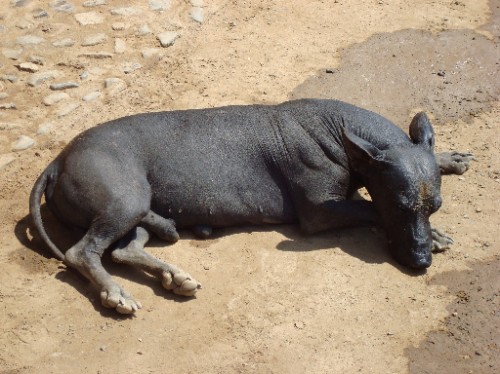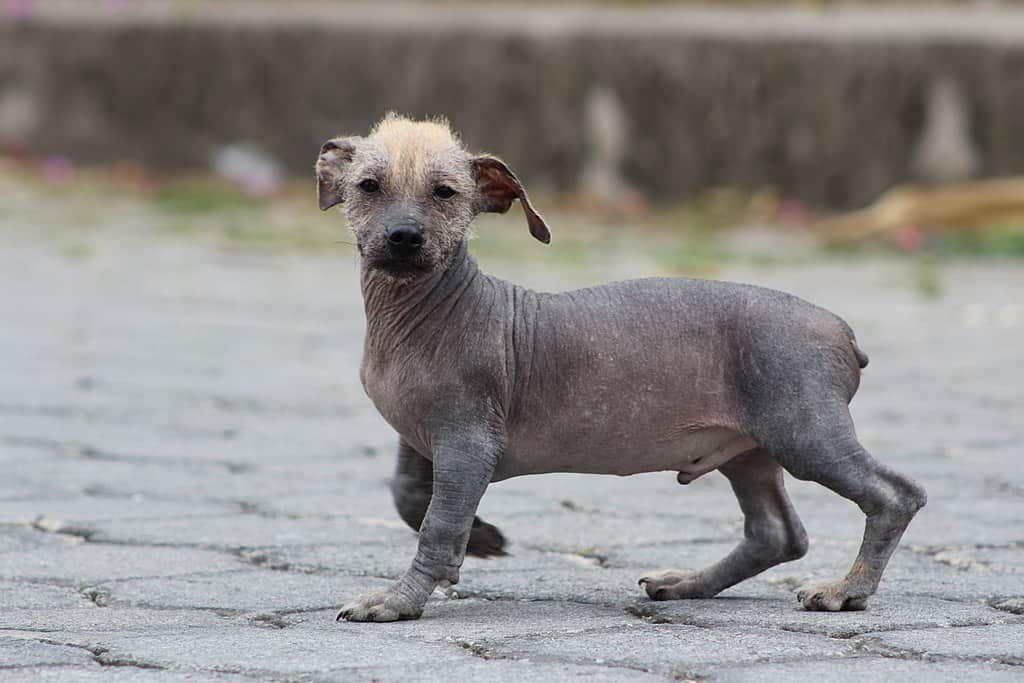Hairless dogs have always been fascinating. They are beautiful in their own rights but most importantly, they arouse a lot of curiosity.
When you look at one, you cannot help but wonder how the body manages to regulate its temperate.
See, fur doesn’t only add to the beauty of the dog. It protects him from the elements.
That is why hairy canines such as Chow chows and huskies originated from the tropics while short-haired varieties are ideal for warmer regions.
To help your learn more about hairless dog breeds, we have put together a guide about one of the rarest by the name of Ecuadorian hairless dog (EHD).
You have probably never heard about this dog before.
For those who have, we bet there are many things you don’t know about him.
Lucky for you, we have 12 things you probably didn’t know about this unique breed.
1. The breed originated from Ecuador’s Santa Elena Peninsula
As the name suggests, the EHD has its roots in the South American country of Ecuador.
The actual place of origin is the Santa Elena Peninsula, which is located at the westernmost point of the country.
Originally called Sumpa, Saint Elena is the border between Santa Bay Elena Bay (on the northern side) and the Gulf of Guayaquil (on the southern side).
The area is mainly dry and abounds in natural resources such as salt mines and oilfields.
Since it is located near the ocean, it is famous for hosting whale watching which happens to date.
2. It is a cross between the Xolo and the Peruvian hairless dog
By looking at the Ecuadorian hairless dog, you can tell that he has similar features as the Peru Hairless dog (PHD).
That’s because he is a descendant of the popular Peruvian dog.
The breed resulted from crossing the PHD and another famous dog from Mexico known as the Xoloitzcuintli, or Xolo.
The latter comes in both coated and hairless varieties. Your guess is right—the hairless one is what mixes with the PHD to produce this enthralling cross-breed.
3. But it is not an official breed
Sadly, the EHD is not an official dog breed.
There’s no kennel body that has it as one of the accepted breeds in their registries. This is mainly because he is considered to be a descendant of the Peruvian hairless dog.
Don’t expect to find one in the ring or any dog event.
4. It is the rarest in the hairless dog category
There are more than 10 hairless dog breeds in the world. Of all of them, the Ecuador hairless dog is the rarest.
For a long time, the breed existed in Santa Elena and nearby areas but as of this writing, it is only in the Gulf of Guayaquil.
During the Spanish period (Caesar’s era between the 5th and 15th centuries), the number of EHDs was greatly reduced.
Many lost their lives due to cruelty, disease, hunger, and war.
Eventually, the few that remained were confined to the Gulf of Guayaquil to this day.
5. The dog has absolutely no hair on the body
Hairless breeds like the Chinese crested have some fur on them. Their heads and legs are full of fur.
Well, for the EHD, the entire body has no hair.
He walks around naked hoping the sun doesn’t shine too bright or that snow doesn’t fall.
The phenomenon is caused by the mutation of a dominant hairless gene inherited from one or both parents.
6. But the head has some fur remnants

The only traces of fur in an Ecuadorian hairless dog are found on the face.
The Peruvian hairless dog also has the same physical trait.
Some Xolos are similar although some don’t have hair on the body completely.
The color of the skin is greyish brown and the hair bears a reddish color that appears as though the fur has been bleached.
The fur is not as long as that of a Chinese crested though. It is rather short and randomly dispersed on the face area.
7. The EHD has long legs
Although the Ecuadorian dog is not the tallest dog in the room (stands at a height of 15-18 inches), it does have one of the longest legs.
Hunting dog breeds have long legs to help during the hunt, so this trait is befitting the breed.
The stride length affects the force with which the leg strikes the floor.
The longer the leg, the longer the stride and the faster the animal. Being fast during hunting is a major plus.
8. Has no premolar teeth
One of the characteristics of hairless dogs is the lack of premolars in their mouths. The Ecuador hairless dog is no exception.
For some reason, the dominant gene for hairlessness has a direct effect on teeth as well.
Dogs with this gene often suffer missing teeth. Sometimes, it’s the premolars but there can be an absence of incisors and canines as well.
9. Has a short tail
Besides its long legs, another distinguishing trait of the EHD is his short tail.
Most of his counterparts have long straight tails except for a few including the Peruvian Inca Orchid.
A short tail is a result of the dominant T-box gene combines with a recessive gene.
10. His body turns golden during sunsets
Like most hairless dogs, the Ecuadorian hairless dog has grey or brown skin.
The color of the eyes and nose depend on the coat color.
However, when the sun sets in the sky, the color of the skin becomes golden as it reflects the color of the sun. The sight is mind-blowing.
11. Has a strong prey drive
If you know a thing or two about the Peruvian hairless dog, you are probably aware that he was bred as a hunter.
He would hunt small game such as rabbits, birds, and bats.
The EHD was equally developed to do the same. He would accompany hunters in the wild in search of food.
In addition, locals in ancient times raised the dog as a pet.
Related Post: 18 Best Bear Hunting Dog Breeds
12. The breed is active and affectionate
The Ecuadorian hairless dog, like his cousin the Peruvian hairless dog, is great to own.
As a passionate hunter, he loves to put his feet to work.
Daily workouts are a must to make him happy and healthy. He is also affectionate, playful, and fun to cuddle with.
The baldness makes his attractive to touch as the bare skin touches yours.
Closing Thoughts
The Ecuadorian hairless dog is a mysterious breed to a lot of people.
His rarity makes it harder to know him at a deeper level.
We sure hope to meet the breed someday in the future. For now, we will settle on reading more about him.
Related Posts:
10 Interesting Facts You Probably Didn’t Know About Seppala Siberian Sleddog
17 Facts You Never Knew about Hawaiian Poi Dog
Formentino Cane Corso: Top Facts You Probably Didn’t Know About This Dog Breed
As an Amazon Associate, we may receive a small commission from qualifying purchases but at no extra cost to you. Learn more. Amazon and the Amazon logo are trademarks of Amazon.com, Inc, or its affiliates.

